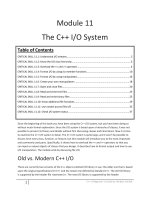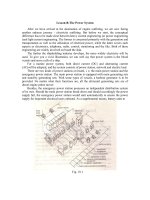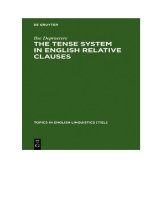Malaysia educational system
Bạn đang xem bản rút gọn của tài liệu. Xem và tải ngay bản đầy đủ của tài liệu tại đây (303.19 KB, 25 trang )
EDUCATIONAL SYSTEM
OF
MALAYSIA
PHILIPPINES
MALAYSIA
Area
299, 764 sq. km / 115, 839 sq. mi
329,845 sq. km / 127, 354 sq. mi
Local Name
Republika ng Pilipinas
Persekutuan Tanah Melaysiu
Currency
Philippine peso
Ringgit
Political System
Presidential Democratic Republic
Federal Constitutional Monarchy
Population
91, 983, 000
28, 310, 000
Languages
Filipino and English
Malay
28.1% Tagalog, 13.1% Cebuano, 9% Ilocano, 7.6%
54% Malay, 25% Chinese,
Bisaya/Binisaya, 7.5% Hiligaynon Ilonggo, 6% Bikol, 3.4%
7.5% Indian,
Waray, and 25.3% are classified as other
11.8% other Bumiputera
Ethnic Groups
1.7% other
Religions
80% Roman Catholic, 10% other Christian Denominations
60.4% Muslim, 19.2% Buddhism, 19.1% Christianity, 6.3%
and 10% Muslim
Hinduism, and 2.6% other traditional Chinese religions
Geographical Location
Located between 20 and 70 north of Equator. Peninsular
Malaysia is separated from the states of Sabah and Sarawak by
the South China Sea. To the north of Peninsular Malaysia is
Thailand while its southern neighbor is Singapore. Sabah and
Sarawak are bounded by Indonesia while Sarawak also shares a
border with Brunei.
About Malaysia
Malaysia is well-endowed with natural resources in areas such as
agriculture, forestry and minerals. In terms of agriculture, Malaysia is
one of the top exporters of natural rubber and palm oil, which together
with sawn logs and sawn timber, cocoa, pepper, pineapple and tobacco
dominate the growth of the sector. Palm oil is also a major generator of
foreign exchange.
Tin and petroleum are the two main mineral resources that are of
major significance in the Malaysian economy. Malaysia was once the
world's largest producer of tin until the collapse of the tin market in
the early 1980s. In the 19th and 20th centuries, tin played a
predominant role in the Malaysian economy. It was only in 1972 that
petroleum and natural gas took over from tin as the mainstay of the
mineral extraction sector.
Government
Malaysia is a federal constitutional
elective monarchy. The federal head of state
of Malaysia is the Yang di-Pertuan Agong,
commonly referred to as the King of
Malaysia. The Yang di-Pertuan Agong is
elected to a five-year term among the nine
hereditary Sultans of the Malay states; the
other four states, which have titular
Governors, do not participate in the
selection.
Legislative power is divided between federal and state
legislatures. The bicameral parliament consists of the
lower house, the House of Representatives or Dewan Rakyat
(literally the "Chamber of the People") and the upper house,
the Senate or Dewan Negara (literally the "Chamber of the
Nation").
Executive power is vested in the cabinet led by the prime minister;
the Malaysian constitution stipulates that the prime minister must
be a member of the lower house of parliament who, in the opinion
of the Yang di-Pertuan Agong, commands a majority in parliament.
The cabinet is chosen from among members of both houses of
Parliament and is responsible to that body.
Administrative divisions
Administratively, Malaysia consists of 13 states (11 in peninsular
Malaysia and 2 in Malaysian Borneo) and 3 federal territories. Each
state is further divided into districts (daerah or jajahan in Kelantan)
and a subdivision of a district is called mukim. As Malaysia is a
federation, the governance of the country is divided between the
federal and the state governments.
EDUCATION
Pre-School
Attendance in a pre-school programme is not
universal and generally only affluent families can
afford to send their children to private, for-profit preschools.
Primary Education
There are two main types of public primary schools in Malaysia: national
(Sekolah Kebangsaan in Malay, abbreviated as SK) and national-type
(Sekolah Jenis Kebangsaan, abbreviated as SJK).
National-type schools are further divided into Chinese national-type
schools (Sekolah Jenis Kebangsaan Cina, SJK(C)) and Tamil national-type
schools (Sekolah Jenis Kebangsaan Tamil, SJK(T)).
Primary education begins at the age of 7 and ends at 12.
Students are promoted to the next year regardless of their
academic performance (poor curriculum induced).
By degree of government funding, national schools are
government-operated, while national-type schools are mostly
government-assisted, though some are government-operated.
Primary education consists of six years of education, referred to as
Year 1 to Year 6 (also known as Standard 1 to Standard 6). Year 1 to
Year 3 are classified as Level One (Tahap Satu) while Year 4 to Year 6
are considered as Level Two (Tahap Dua).
From 1996 until 2000, the Penilaian Tahap Satu (PTS) or the Level One
Evaluation was administered to Year 3 students. Excellence in this
test allowed students to skip Year 4 and attend Year 5 instead.
Secondary Education
Secondary education in Malaysia is conducted in secondary
schools (Sekolah Menengah Kebangsaan) for five years.
National secondary schools use Malay as the main medium of
instruction.
• The only exceptions are the Mathematics and Science subjects as well
as languages other than Malay, however this was only implemented
in the year 2003.
Malaysian national secondary schools are sub-divided into several types:
1.
2.
3.
4.
5.
National Secondary School (Sekolah Menengah Kebangsaan)
Religious Secondary School (Sekolah Menengah Agama)
National-Type Secondary School (Sekolah Menengah Jenis Kebangsaan)
Technical Schools (Sekolah Menengah Teknik)
Residential Schools and MARA Junior Science College (Maktab Rendah Sains
MARA).
Pre-University
After the SPM, students from public secondary school
would have a choice of either studying Form 6 or the
matriculation (pre-university). If they are accepted to continue
studying in Form 6, they will also take the Sijil Tinggi
Persekolahan Malaysia (which is usually abbreviated as STPM)
or Malaysian Higher School Certificate examination
Form 6 consists of two years of study
1.
2.
Lower 6 (Tingkatan Enam Rendah)
Upper 6 (Tingkatan Enam Atas)
• Although it is generally taken by those desiring to attend public
universities in Malaysia, it is internationally recognised and may also
be used, though rarely required, to enter private local universities for
undergraduate courses.
Tertiary education
Tertiary Eduication is heavily subsidised by the
government. Applicants to public universities must have
completed the Malaysia matriculation programme or have
an STPM grade. Excellence in these examinations does not
guarantee a place in a public university.
The classification of tertiary education in Malaysia is
organised upon the
Malaysian Qualifications Framework (MQF) which seeks
to set up a unified system of post secondary
qualifications offered on a national basis both in the
vocational as well as higher educational sectors.
Students also have the choice of attending
private institutions of higher learning. Many of
these institutions offer courses in cooperation
with a foreign institute or university. Some of
them are branch campuses of these foreign
institutions.
Some foreign universities and colleges have also set up branch
campuses in Malaysia, including:
Monash University, Australia.
The University of Nottingham, United Kingdom
SAE Institute, Australia
Swinburne University of Technology, Australia
Curtin University of Technology, Australia
Raffles Design Institute, Singapore
Postgraduate programmes
Postgraduate degrees such as the Master of Business Administration (MBA)
and the Doctor of Business Administration (DBA) are becoming popular and
are offered by both the public universities and the private colleges.
All public and most private universities in Malaysia offer Master of Science
degrees either through coursework or research and Doctor of Philosophy
degrees through research.
Vocational programmes and polytechnics schools
Besides the university degrees, students also have the
option of continuing their education in professional courses
such as the courses offered by the ICSA (Institute of Chartered
Secretaries and Administrators) etc. Polytechnics in Malaysia
provide courses for diploma level (3 years) and certificate level
(2 years).
Other types of Schools
Islamic religious schools
Chinese independent high schools
International schools









